
Shan State, in particular the “Golden Triangle” which spans across Myanmar, Laos and Thailand, has a rich, yet tumultuous history!
Fortunately, Myanmar’s “Wild East” has now been tamed so it is safe to visit. Adventurous travellers come here to hike to remote hill tribes, not yet affected by mass tourism.
Why Travel to Kengtung in Myanmar’s “Wild East”?
- The low-down: This part of the world has been closed off to foreigners for a long time, and only recently opened up. Some areas to the northeast of Kengtung are still off-limits. Come visit the hill tribes and adore the beautiful natural scenery and rice paddies.
- The brightest highlight: The friendly hill tribes are a gem. They receive foreign visitors with open arms. Please behave very well and follow the rules of responsible tourism. Read these expert opinions about Responsible Travel & Blogging.
- Intrepid destination: Absolutely. The area is hard to reach, can only be travelled with an approved guide, no overnights are allowed outside the town of Kengtung, and few tourists visit the area. This was true back in 2017 and may change soon.
- Globerovers score (10 is highest): I have spent several days in the area and travelled in all directions with Kengtung as my base. Really enjoyed it. I’ll score it 9/10.
Getting here
Getting to Kengtung has limited options:
1) Currently, foreigners are not permitted to travel to Kengtung by road from elsewhere in Myanmar.2) Most visitors arrive here by plane, either from Yangon, Mandalay, or Heho near Inle Lake.
3) The only arrivals by land are across the Friendship Bridge from Mae Sai in northern Thailand to Tachileik in Myanmar.
4) From Tachileik take the limited bus service, a shared, or private taxi for the 4-5-hour journey which winds its way through a narrow and picturesque river valley.
5) Mann Yadanarpon Airlines has limited flights from Tachileik to Kengtung (Kyaingtong).

Table of Contents
Myanmar’s Shan State
While Myanmar is not considered to be one of the most ethnic and culturally diverse countries in the world, it certainly offers some of the most approachable and friendliest people on our planet!
With no less than 135 distinct ethnic groups officially recognised by the local government (which excludes their much persecuted Rohingya people), the Bamar people account for almost 70% of the total population. Second in population numbers are the Shan people, followed by the Kayin, Rakhine, Chinese, Mon, Kachin and several smaller groups such as the Wa, Lahu, and Palaung
Myanmar’s “Wild East” is open for tourists, but few are coming.
Shan State, located in the central far eastern part of the country, is the largest administrative region of Myanmar. Covering an area of almost 156,000 square kilometres, this state shares international borders with China to the north, Laos to the east, and Thailand to the south. With an estimated population of almost 6 million people, it is the fourth most populated region after the Yangon Region, the Ayeyarwady Region, and the Mandalay Region.

What truly sets Shan State apart from the rest, is the historic cultural influence from its neighbours, particularly China and Thailand.
The Shan people, who dominate this state culturally and economically, arrived in this area along with the Mongols when the Pagan Kingdom (the first Burmese empire: 849 to 1287) fell to the Mongols in the 13th century. The Mongol invasion was launched after the last true ruler of Pagan, King Narathihapate (who reigned 1254 to 1287) refused to pay tribute to Kublai Khan, the “Great Khagan of the Mongol Empire”. The Mongols, under Kublai, delivered a crushing defeat at the “Battle of Ngasaunggyan” (1277), followed by the Battle of Bhamo (1283) and the Battle of Pagan (1287), which then brought an end to the Pagan Kingdom and the construction of the temples at their capital, Bagan.
Along with the victorious Mongols came the Shan people who made this part of the world their new home and quickly dominated much of the eastern and northern regions of Myanmar. They claimed much of the fertile lands and became powerful landlords, dominating all other ethnic groups.
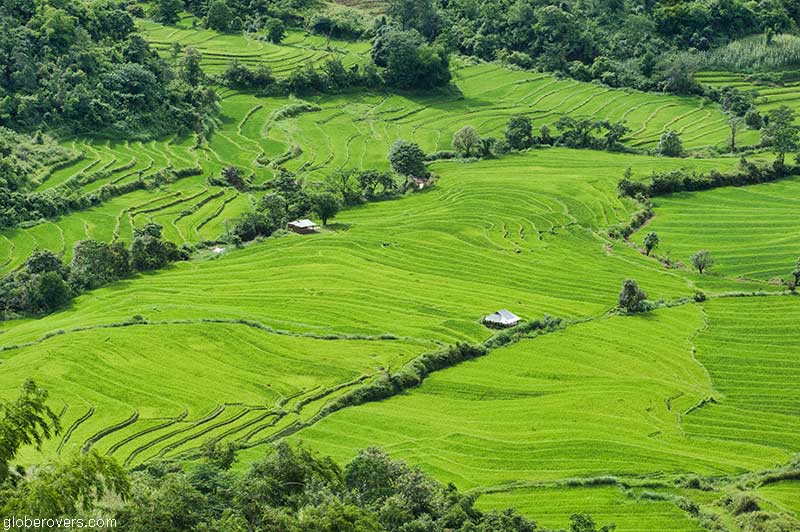
At the time when the British took over Burma, which lasted from 1824 to 1948, there were 18 major Shan states ruled by royals, and 25 lesser states ruled by other officials. When the border lines with Thailand were drawn up, the eastern states became part of Thailand, while the central and western states paid tribute to British Burma.
After independence from Britain, the Shan people engaged in a military struggle to gain more autonomy from the Burmese-Myanmar government. However, by 1996 most groups had signed a peace treaty with the Yangon government, promising more autonomy to the various ethnic groups.
The ethnic minorities, such as the Wa, Palaung (Ta’ang), Akhu (Akhe), Akha, Lisu, Lahu, La (Ka-La), Loi (Ka Wo), Ann (Eng), Pa O, and others who mostly arrived from Tibet and China, were forced to mainly inhabit the green rolling hills around Shan State, hence becoming known as the “hill tribes”.
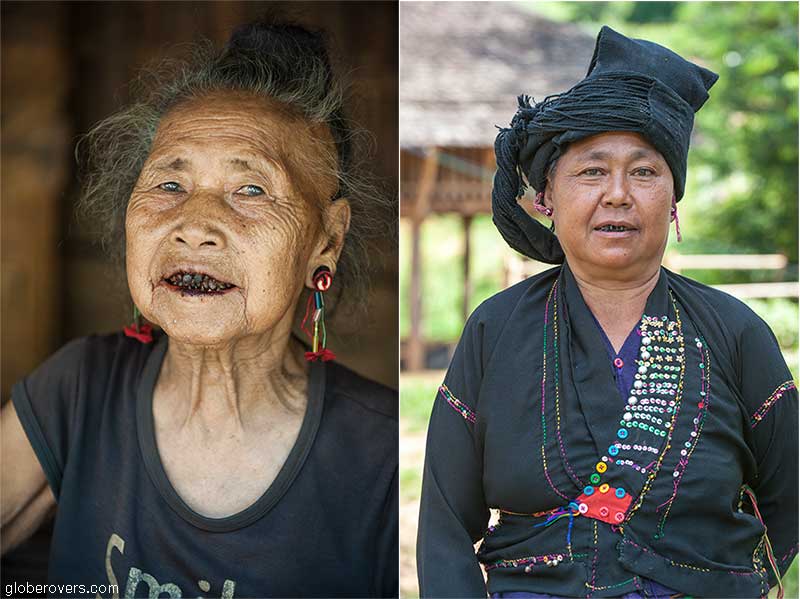
Taunggyi, the capital of Shan State, is located about 260 km to the south-southeast of Mandalay, Myanmar’s second largest city after Yangon.
Just over 400 km to the far eastern part of the state, lies Kyaingtong (also referred to as Kengtung or Keng Tung). Located east of the Salween River, at the crossroads of trade routes to neighbouring Thailand, Laos and China’s Yunnan province, it is the largest town in eastern Shan State and was once known as the capital of the “Golden Triangle”.
Highlights of Kengtung
1) At One Tree Hill is a solitary 264-year-old tree named Thit Ta Bin Taung and is 66 metres high. Visit the nearby Zawmmoon Matyan Monastery.2) On a hill opposite Naung Tung is a 20 metres high Buddha statue pointing across town.
3) Naung Tung Lake in the middle of town is a great place to sit outside at night, eating, drinking and people watching.
4) Watin Monastery and its temple is a peaceful, and beautiful retreat from the hot sun.
5) The Kengtung morning market is a beehive of activity, particularly in the morning. Here you can buy anything you need, especially fresh exotic fruits. Enjoy a bowl of Shan noodles at one of the many small restaurants.
6) Near the Kengtung Resort Hotel, look out for the old city walls and a city gate.
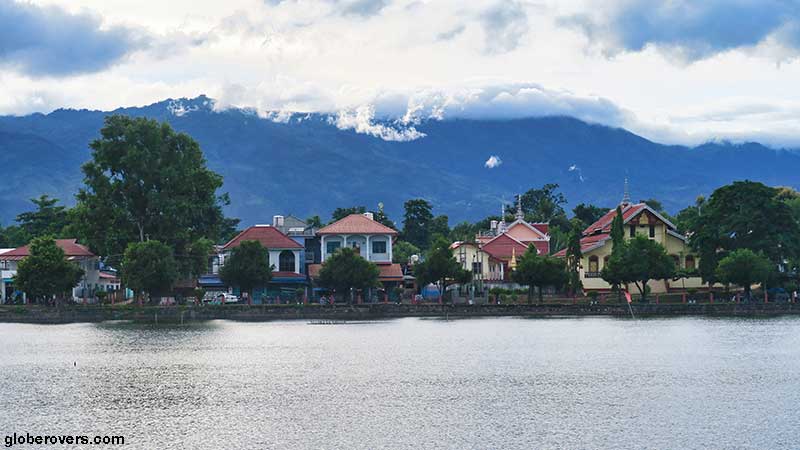
During British rule, Kengtung was an important British administrative outpost, as the leftover colonial buildings can attest.
Decades of an ethnic insurgency, a brutal military rule, and smuggler economies, have left much of the region impoverished and under-developed. The region is known for its trafficking of resources, people, drugs and endangered species. Mong La, at the Chinese border, is a shabby border town which has grown to become a key hub of trade in endangered animals and animal products. It is known as one of Southeast Asia’s largest open wildlife markets where rare animals, many of which are protected by international treaties, are sold to Chinese buyers.
Since the region opened to foreign tourism in 1993, it has become an appealing “off-the-beaten-track” destination among intrepid travellers who crave authentic experiences unaffected by western values. However, tourism remained insignificant prior to the victory of Aung San Suu Kyi in the 2015 elections and her subsequent role of State Counsellor in April 2016. Since then, Myanmar has seen an increase in foreign tourism, though the Kengtung region still hosts an insignificant number of tourists. Mong La near the Chinese border and its surrounding areas remain off-limits to foreigners as well as Myanmar citizens who don’t have a valid reason to visit.
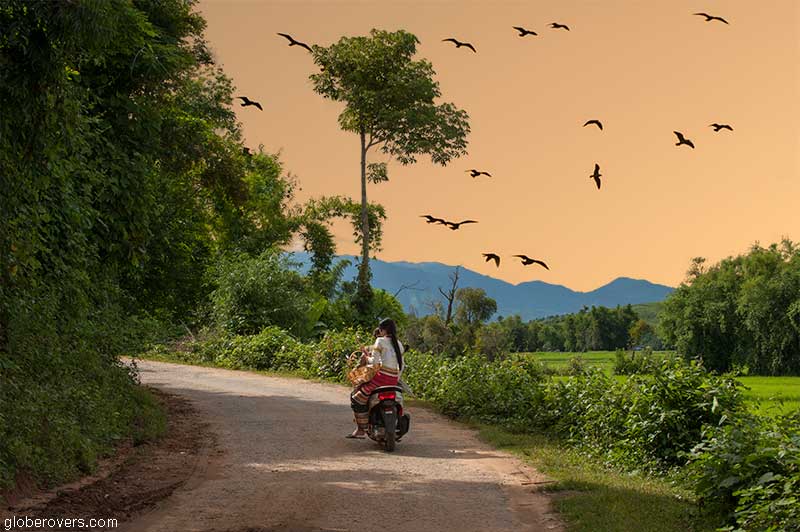
One reason for the limited arrivals in Kengtung, is the rebel activities in the wider region. Foreigners are presently not allowed to travel overland to Kengtung from other major tourist hubs in Myanmar such as Yangon, Mandalay, Inle Lake, or the state capital Taunggyi. However, the road leading from northern Thailand is currently open to tourists.
With few visiting foreigners, excluding Thais from across the border, the Kengtung area remains virgin territory to intrepid travellers
It is reported that fewer than 5,000 foreigners (most are Thai day-trippers) have ventured into Shan State from across the Friendship Bridge at Thailand’s most northern town of Mae Sai. Few visitors continue north to Kengtung.
Travel from within Myanmar can only be undertaken by a domestic flight, mainly limited to departures from Yangon, Heho, and Mandalay. In the rainy (or green) season, the number of flights is reduced.
Hiking routes around Kengtung
The hiking routes to the hill tribes are dispersed in all four directions. Note that you do need a local registered tour guide, a rule which is monitored by police checkpoints along the main roads. While some of the hill tribe villages are a short drive from Kengtung, followed by a short hike, other hikes are over two hours of driving followed by over three hours of hiking. All must be done in one day as foreigners are currently not allowed to stay overnight outside of Kengtung. Staying overnight would be a great experience so we hope this rule will change in the near future.
Hill Tribes of Shan State
While Kengtung has much to offer and can easily keep you occupied for a few days, the main reason why foreign visitors come here is to head out of town. So grab your hat, Kengtung, walking stick, and your mandatory local guide. The guide and his driver will make sure everything goes smoothly and you will pass through a few checkpoints without any hassle. Do take along your passport.
Every night you will need to return to Kengtung as foreigners are currently not permitted to stay overnight in the villages, or anywhere outside of town.
The friendly hill tribes, some are very isolated,
live in small villages in the hills.
It is possible to hike to various hill tribe villages in all four directions. Some of the most accessible villages are a short drive out of town followed by a short walk. These are typically the most-visited villages, though you may not come across any fellow travellers, especially in the green (low) season. The more remote villages are further out of town and hiking can be up to three or four hours away in any one direction. If foreigners were allowed to overnight out of town, then the even more remote villages could be explored. Even so, an early start to the day with a brisk hike can take you some distance into the hills to reach some of these remote villages which hardly ever encounter foreigners.

Akha woman at Ho Kyein Htet Akha village 
Akha woman at Ho Kyein Htet village
Myanmar is known for its friendly people. Known as the “real land of smiles”, or the “land of the biggest smiles”, the people of Myanmar are one of the main reasons why foreigner travellers come here, and return multiple times. Whether they are the predominant Bamar people, or the other main groups such as the Chin, Kachin, Kayin, Mon, or Shan people, they are generally very friendly and respectful of foreign visitors. But, wait until you have met the hill tribes, in particular those around Shan State.
While language is obviously a problem to connect with foreign travellers, you will have a local guide with you who speaks the local dialects, which are mostly unique from one another and quite incomprehensible to the Bamar people. With your guide by your side speaking the local dialect of the tribe you are visiting, you will be astounded with how inquisitive these people are about your life. Their hospitality will warm your heart and you will experience the warmth you have come to enjoy. Therefore, make sure you bring a few gifts of your own.
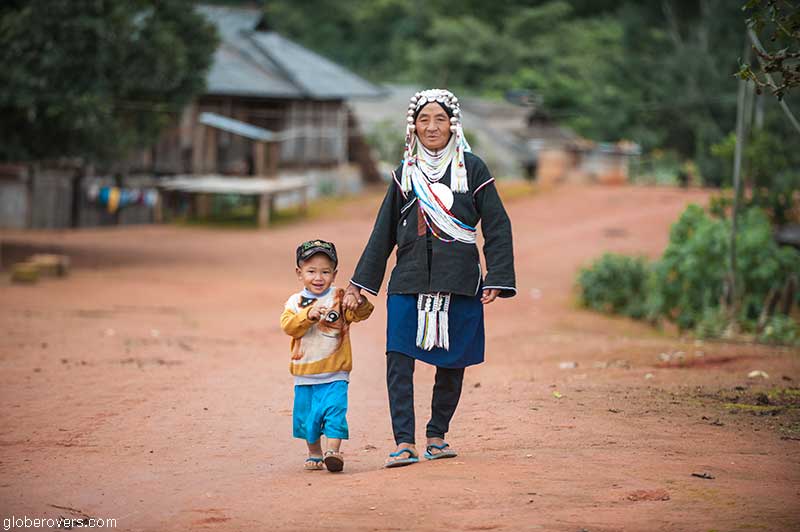
Some of these villages are very remote and don’t have any shops nearby to buy food, medicines or anything else. It’s a very long hike for them over the hills to the nearest settlement where they buy limited supplies with the little money they have.
Money is mainly generated from trading their animals such as pigs, chickens, and cows (or buffaloes), and from the rice and vegetables they produce on the green terraces. Bring along headache tablets and ointments for pain such the local version of Tiger Balm. Best not to bring different medicines as most villagers have never been to school and are completely illiterate. You don’t want them to confuse headache tablets with heart tablets or laxatives.
Kids are kids, and in these remote villages the kids hardly ever get the pleasure of eating something special. While candies are not recommended by proponents of sustainable travel, bring along some healthy snacks. Fresh fruits are good gifts but do check with your guide which fruits are available in the villages, such as bananas. Clothing is another great gift, but again check with your guide as many tribes have strong clothing guidelines to reflect their cultural heritage. Be creative with your gifts and in doing so you will return their hospitality multifold.
While there are several hill tribes in the region, we mainly visited the Wa, Wa Ann, Ann, Akhu, Akha, Lahu, and the Lahu-shi people
There are several main groups and subgroups of tribes reachable on day trips from Kengtung. Among these are the Wa, Wa-Ann, Ann, Palaung, Akhu, Akha, Lisu, Lahu, Lahu-shi, Loi, and the Pa O people.
The normal marrying age of the hill tribe girls is about 14 years, or as soon as the girl has her first menstrual period, which is the sign of reproductive readiness. By this time girls normally have their future husband in mind, and as sex before marriage is not allowed, the two will soon get married, normally paid for by the boy’s family, and almost immediately start working on their first baby. Couples are generally of similar age and the family does not enforce their own decisions on who should marry who. It’s all determined by love and each selects their own future spouse.
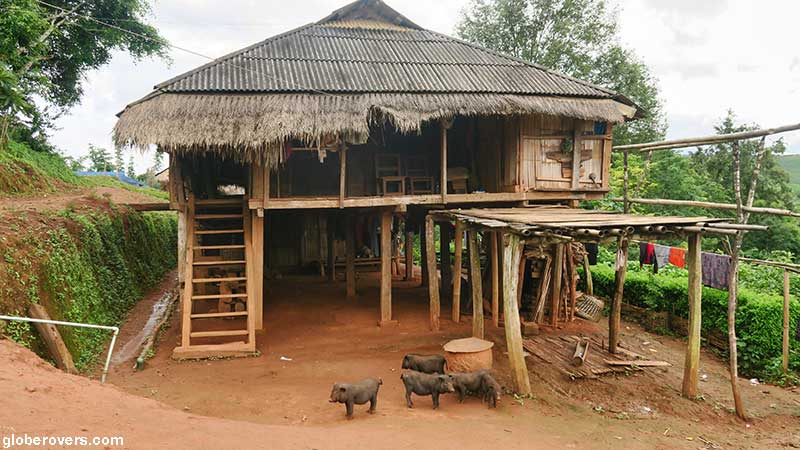
Contraceptives are not allowed, and neither are they available, often never heard of as these people live very basic lives with limited or no education. Therefore, most women give birth to several children during their reproductive lifetime, though child mortality is high and many will not survive to become adults. Should an unmarried girl fall pregnant before marriage, it is referred to as a “mistake” and in some villages the boy’s family needs to pay the chief of the village compensation, such as buying him a pig which is then slaughtered and shared with the people in the village.
If the parents of the couple agree to the marriage then so be it. However, should the parents not agree to the marriage, the boy’s family need to pay a substantial compensation to the girl’s family. The girl will remain with her parents with the new baby. Newly married Wa Ann couples will move in with the boy’s family, although some tribes have the rule that the newlyweds move in with the girl’s family.
Almost all babies are born at home, often with the help of a local midwife or a government-provided nurse. Babies are not officially registered and the exact birth date is unimportant and generally not remembered a few weeks later. What is important though, is the lunar year of the birth. Most adults know in which lunar year they were born but have no idea how old they are or when exactly they should celebrate the exact day of their birth. Birthday celebrations don’t exist among these hill tribes. About two to three weeks after birth the new baby will be given a name, which is done during an important ceremony attended by the entire village.
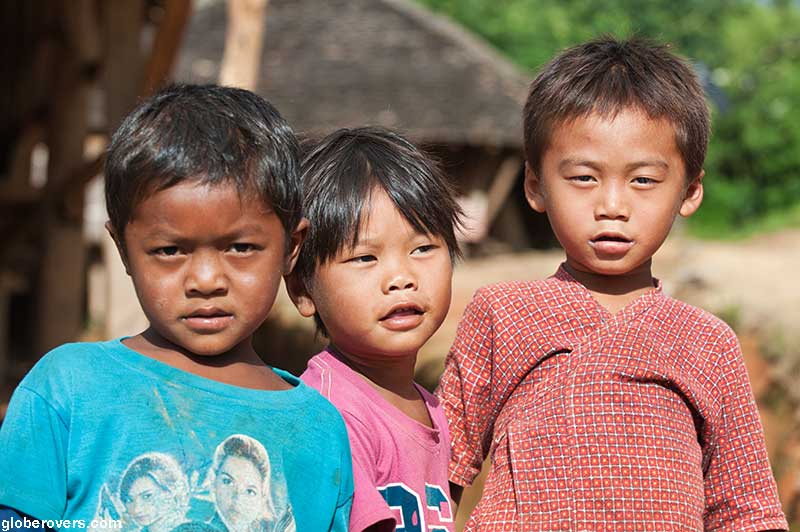
Most of the hill tribes have no access to toilets, other than to head into the nearby bushes. There seems to be little need for toilets among these people, as some tribes have turned down suggestions by concerned outsiders to fund the construction of toilet facilities.
The chief of the village, and the shaman (medicine man), are the most important individuals in the village. The chief of the village is responsible for most of the important decisions and arbitrations in the daily life of his village. His term could be for life, or could be as short as a few weeks, depending on his own job satisfaction and the approval ratings from his villagers. Most often the chief is selected for a few years and then turns over his important duties to a new chief.
Most villages also have a shaman, who is more prominent and revered among Animist villages, than in Buddhist or Christian villages. Among the Animists, the shaman, which is an inherited and lifetime position, is responsible for calling up the ancestors for advice and for keeping the communication channels open with the spirits of the “friendly ancestors”.
If you are lucky, the shaman will give you a warm welcome complete with a blessing ceremony and tea
He is also tasked with keeping the evil spirits away which includes performing of rituals at designated places in and around the village, as well as in his house and sometimes in the houses of the villagers. He is also the medicine man of the village, an almost exclusive role in the non-Animist villages. In some villages, the shaman may be the first person to meet visitors and will conduct a welcoming ceremony and pray for each individual while holding their hands. Larger villages may even have more than one shaman to take care of the many tasks laid upon them.
Both men and women work in the farmlands around the villages. Even young boys and girls work in the fields. Once a girl has a baby, she may stay in the village to take care of the baby. Once the child is old enough, the mother goes back to working in the fields while family members, such as grandmothers, look after the child. Men are generally responsible for the building and repairing of houses and for making knives and axes at the blacksmith hut. Women are generally responsible for procuring and preparing food, though men easily take over when the woman is away or not able to cook.
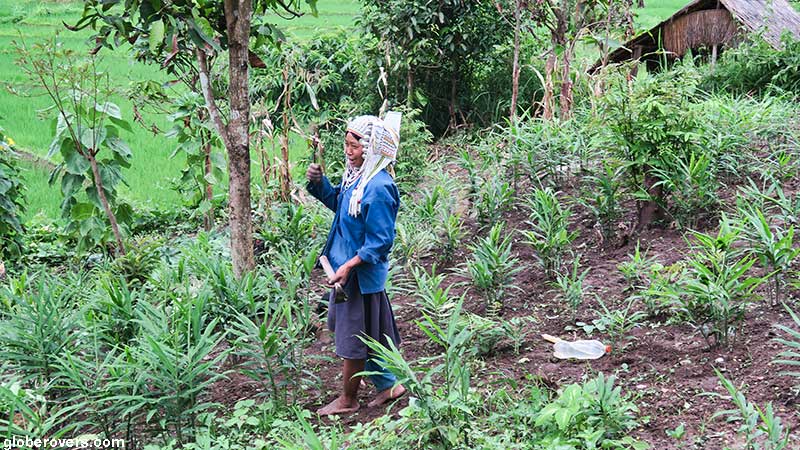
Medicine as we know it does not exist in most of the hill tribe villages. They either use remedies collected from nature or if that does not help they may go to another village and ask for help. In serious cases, they may go to a nearby town and get medical help, though money is limited to pay for medicines and treatment.
Neither the federal nor the local governments provide much, if any, support to these communities. Unless villages establish their own education systems, there are no schools in the villages. The result is that most of the hill tribes are illiterate, though this is slowly improving.
After life comes death! Upon death in a Christian village, the local priest and the chief of the village visit the deceased body in the family home, and after prayers and blessings, they prepare for the washing of the body. The head of the body must always face east. A few animals will be slaughtered and food prepared for the village. Within three days the body will be buried outside the village. Some Buddhists cremate the bodies, though all Animists will be cremated. Unless the body is cremated, evil spirits may invade the dead body before or even after burial and the body may then return to the village with a bad spirit such as a vampire or a tiger.
Hiking EAST of Kengtung
About 10 km to the east-northeast of Kengtung, passing through wide patches of rice fields, is one of the more easily reached villages of the hill tribes. The village, named Wan My, is home to the Wa Ann (also written as Eng or Enn) tribe with about 300 people living in the 32 very basic houses. There is currently no school in or nearby the village so most of the inhabitants are illiterate.
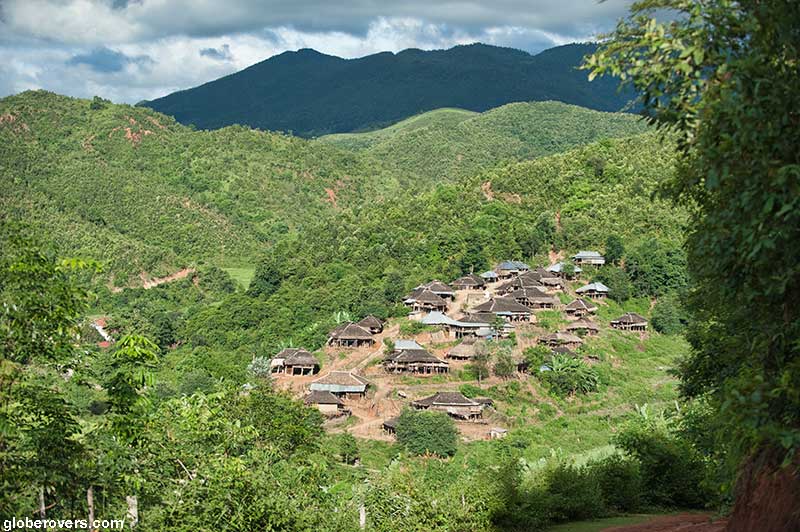
East of Kengtung is the Wa Ann tribe and the pipe-smoking Akhu ladies.
The people in the village are either Buddhists or Animists.
The Wa Ann tribe is known for their black teeth. From the time they get married, women use the bark of the chestnut tree which they burn to charcoal to blacken their teeth. This is further enhanced by chewing a mixture of tobacco leaves, the bark of a young chestnut tree, and ground limestone. The daily use of these items will cause the teeth to become black, though total blackness of the teeth is not achieved until a more mature age.
The main reason for this unusual love of black teeth is due to their belief that animals have white teeth and that humans should be different and have black teeth. This elevates humans above animals. The blackening of the teeth is also believed to protect the teeth from decay, and to prevent bad breath. These people obviously do not have toothbrushes and toothpaste.
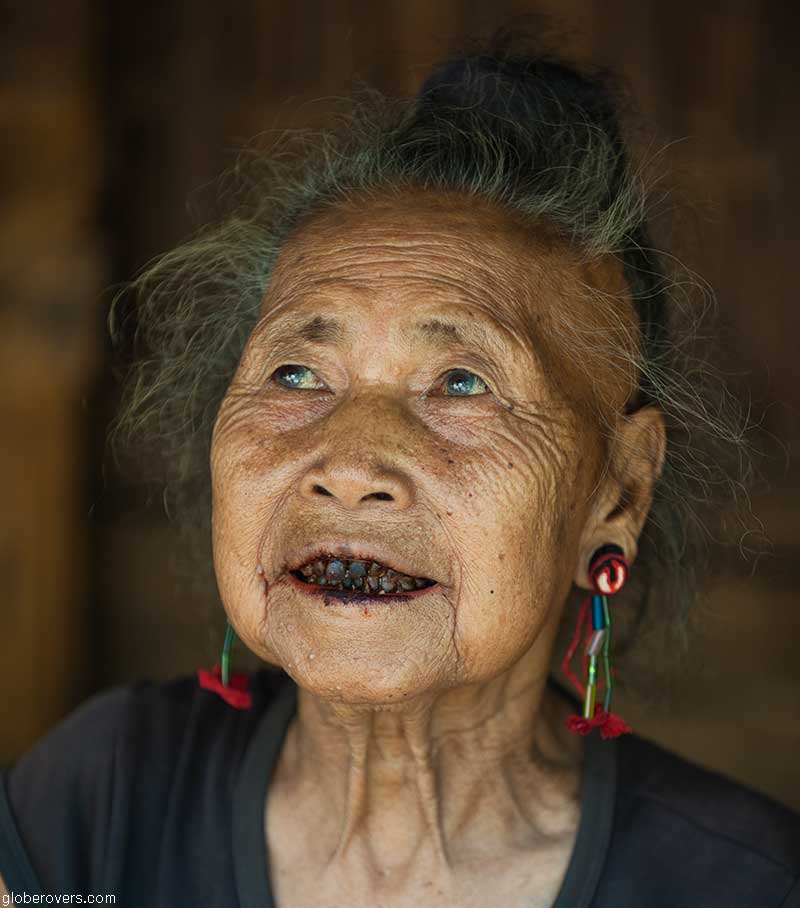
The Wa Ann people still wear traditional clothing, which is mainly a black blouse with a few rows of rainbow-coloured embroidery around the arms and along the lapels. Their black skirts are adorned with thin horizontal rainbow-coloured lines (see page 74).
Houses are very basic wooden constructions which are raised high on stilts with wooden shingles to cover the roofs. The open area below the house is normally where the animals, such as pigs and chickens are kept in their fenced enclosures. During the day the animals are allowed to roam freely around the village.
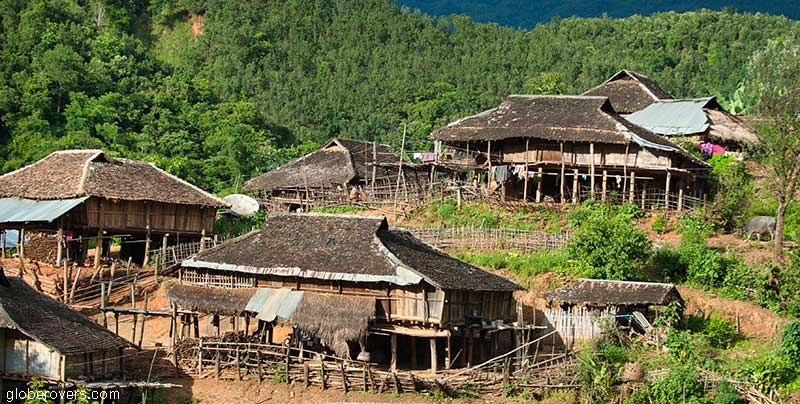
Not far outside Wan My village is the colourful Ko Yin Lay Monastery (Junior Monk Monastery) situated on the banks of a murmuring stream. As the name suggests, this 37-year-old monastery is dedicated to novice monks. At the time of visiting, about 60 to 70 novice monks, cladded in their mix of orange and burgundy robes, were living and studying here. Vegetarian meals are served daily at 06:30 and again just before noon.
Some of the novice monks are so young, one wonders how they live here without their parents. Local men at the monastery are incredibly friendly and will likely invite you for tea and bananas on the carpeted floors in the middle of the temple. Look out for the old ladies in traditional Wa Ann dresses who meticulously sweep the floors every few hours. They are totally emotionless and seem to be in a trance as they sweep so gently with their long grass brooms.
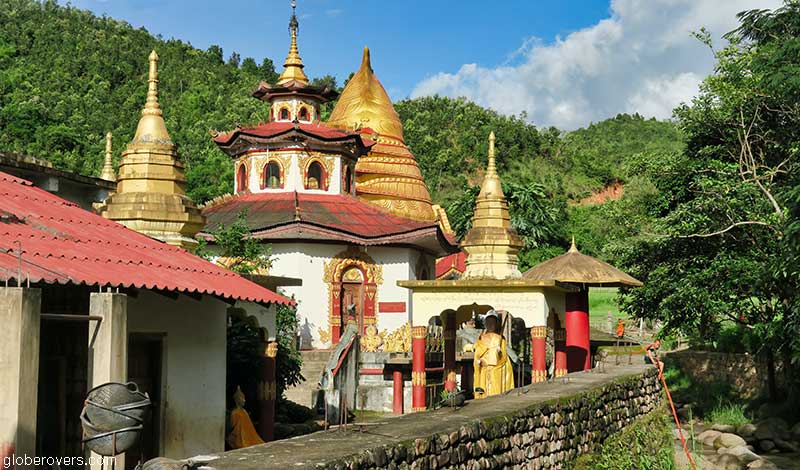
East of Kengtung is the colourful Ko Yin Lay Monastery and the Ka Bar Aye War Peace Pagoda Monastery with stunning views over the valleys!
Located high up on a hill, with stunning views over the rice fields and rubber plantations, is the Ka Bar Aye monastery (meaning War Peace Pagoda in Burmese but referred to as Pra Htard Zom Doi by the Shan people). This 1,200-year-old monastery has been rebuilt and renovated multiple times over the centuries. Some of the oldest parts of the monastery are inside the covered pagoda which has four large Buddha statues, each facing towards one of the four directions. Look out for the exquisite gold-leaf motives on the inner walls and the sparkling domed ceiling.

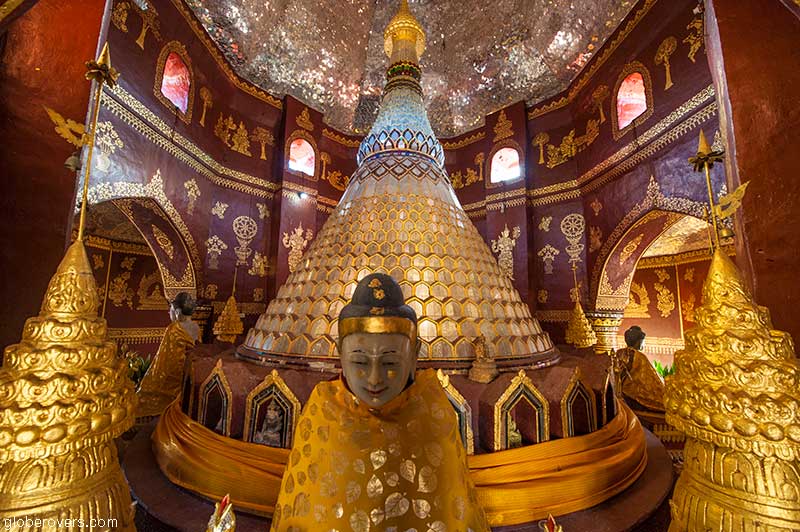
Note that no women are allowed inside the pagoda as it is believed that it contains one of the Buddha’s hairs. The monastery provides no accommodation for either monks or visitors who often come here to meditate in the spacious meditation room overlooking the valley. Usually, only one monk and a few novice monks are around to take care of the facilities.
A few kilometres in the direction of Kengtung and a short walk from the main road lies the Akhu village of Wan Sai. As the name implies, the Akhu is believed to be originally a subgroup of the Akha. The Akhu tribe is small and lives in one of only four groups around the Kengtung area. Wan Sai village consists of about 172 people living in 29 houses. Some 20 years ago something sinister happened in the village. At that time most people converted from being Animists to Christianity (Baptists). The village is known for its friendly pipe-smoking women. Tobacco from nearby fields is dried and smoked in their long home-made pipes.
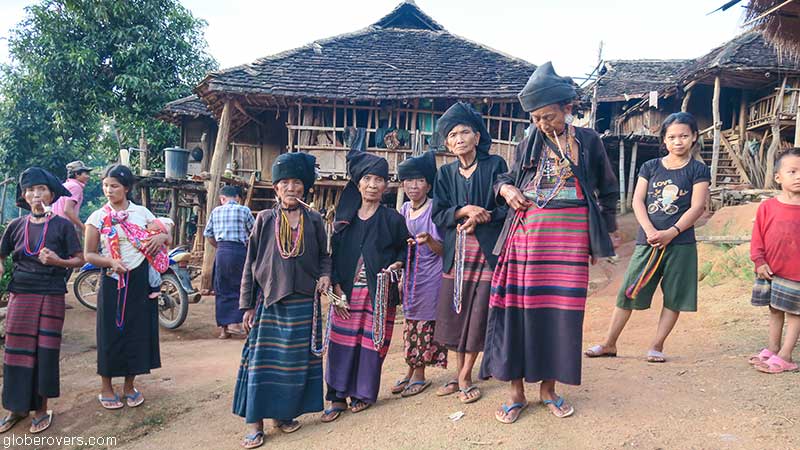
The women all appear to be very experienced too, slowly puffing on their pipes for a while before having to reload and reignite. They are very happy to sell you a pipe and load it for you. They really get excited about sharing their smoking tradition with visitors, while trading their home-made beaded necklaces for a few kyatt (local Myanmar money).
Hiking SOUTH of Kengtung
Southeast of Kengtung lies the Akha village of Ho Lap and the Naung Cho village of the Wa people. High on the hills, about 30 km from Kengtung is the town of Loimwe, meaning “misty mountain”, situated at an altitude of 1,600m. As a former British hill station, the town has a few decaying colonial houses which are reminiscent of the colonial era. Still standing is an old Catholic church which was built by an Italian mission early in the 19th century. An old post office still stands on the lakeshore.
Along the road to Tachileik, at the Myanmar border with Thailand, a long hike along a steep path past coffee plantations and rice paddies leads to the Ho Kyein Akha villages. Ho Kyein Htet village is home to about 400 Akha people living in 65 houses.
South of Kengtung are several Akha villages known for their great cooking
The Akha is the “true hill tribe” as they mostly live at relatively high altitudes and survive mainly on a slash-and-burn economy. While their agricultural methods are rather crude, it sure works in the nutrient-deficient soil typical of these high elevated hilltops. Their main crops include mountain rice, soybeans, and corn.
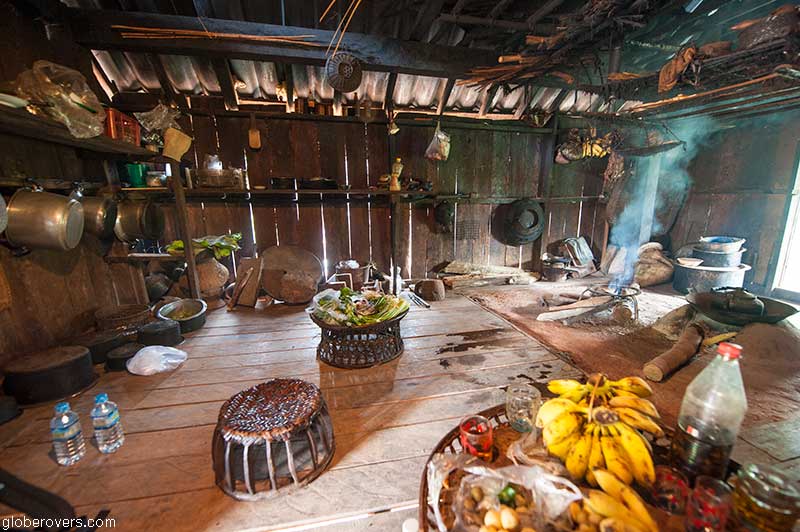

The Akha people here are either Animists, Buddhists or Christian (mainly Catholics or Baptists) – a diversity of religions living in harmony.
A typical Animist Akha village will have two entrances, each with an arching gate standing about two metres high, referred to as a “Law Kong”. At the top of the gate’s wooden cross-beams you will find carvings of birds, swords, and star-shaped charms. Along the sides of the gates are wooden statues of men and women to ward off evil spirits coming from the nearby jungle. It is also believed that these statues prevent disasters and diseases from entering the village.
The Akha tribe differs from most other tribes in how they treat their newlyweds. While most tribes have the new bride moving in with the groom’s family, the Akha’s rule is that the newlyweds need to set up their own nest away from the family home. Only once the father (head of the family home) dies, then his eldest son and his family may move back to the family home to take care of the father’s wife.
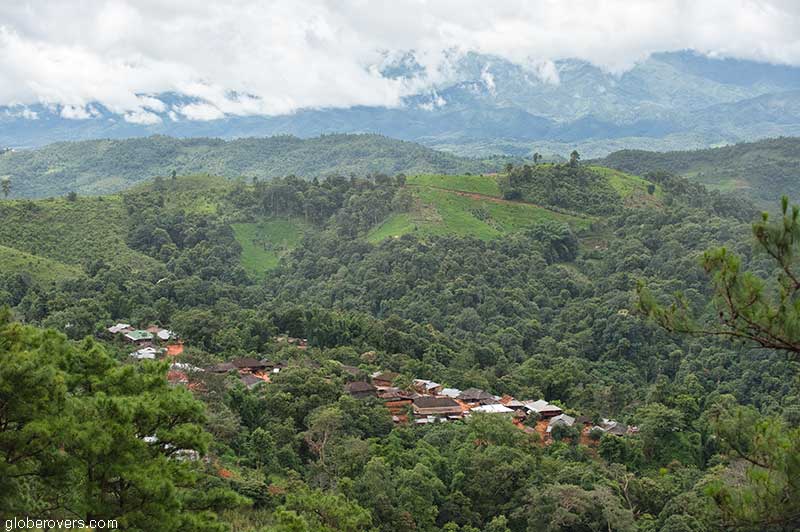
Now that the eldest son is head of the family, he is no longer permitted to sleep with his wife. The only time they are allowed together on the same bed, is during sex. Once the act is over, she must move back to her own bed to sleep. There are some variations to the rule as there are a variety of religions in the village, though all people are Akha and generally adhere to the Akha traditions.
Some Akha Animists have a strict rule that a married couple should never ever sleep together as the man would then lose his power, and here is the reason why: According to folklore, hundreds of years ago an Akha man went to work on a farm every day. One day, he met a beautiful lady. However, unbeknownst to him, she had a big secret. She was a dragon-lady who was human during the daytime but turned back into a dragon after midnight. Day after day they walked past each other and smiled. Then one day she spoke to him and they soon fell in love.
He took her to his village to meet his parents and they all agreed it was a perfect match, and so they married. On the very first night, she revealed to him part of her secret. She explained that they could be in bed together in the evenings and make babies, but she could not sleep with him throughout the night as he would then lose all his power. She did not want to reveal the truth that she would change into a dragon at midnight. He agreed, had sex, and then had to leave her room before midnight. Since then, women and men do not sleep together. While there are no dragon ladies, men still believe they may lose their power. So, now there is a room for the men and a separate room for the women in the house.
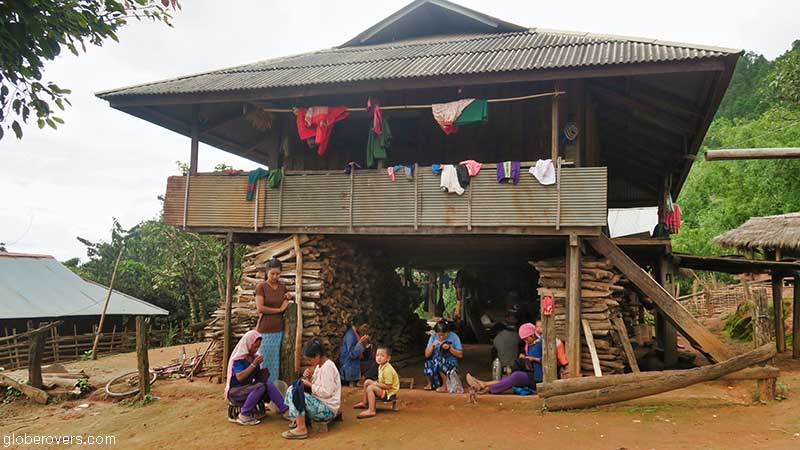
The Animists also believe that the birth of twin babies brought bad luck to the village as the babies are regarded as being of inferior quality like animals, which happens because of reincarnation. In the distant past, the twins’ parents had no choice but to either change religion, or to kill both babies. Nowadays their options are easier. They can give up the babies for adoption. However, the parents must also stay away from the village for one year, or move far away from the Animist village to where there are Christian or Buddhist people.
The Akha people place high value on boys in the family. If a man’s wife has borne him four consecutive baby girls, then he is allowed to try his luck with a second wife, which is generally well-received by the first wife.
Akha ladies wear an elaborate headdress with which they work and sleep as protection against evil spirits
Ahka women like to wear a black blouse, jacket, skirt and leggings. The cuffs of their clothes are often adorned with shiny pieces of metal sewn into it. Their headdresses, which they believe resemble that of a dragon, are the most elaborate among all the hill tribes, and get more elaborate as they grow older.
More reminiscent of a crash-helmet, a headdress includes decorations with silverware, beads, metal balls, and even a variety of beads or shells. They constantly wear their headdresses, at home, when working in the fields (often covering it with a scarf), and even when sleeping. They believe that when the headdress is removed, they become vulnerable to misfortunes brought upon by evil spirits.
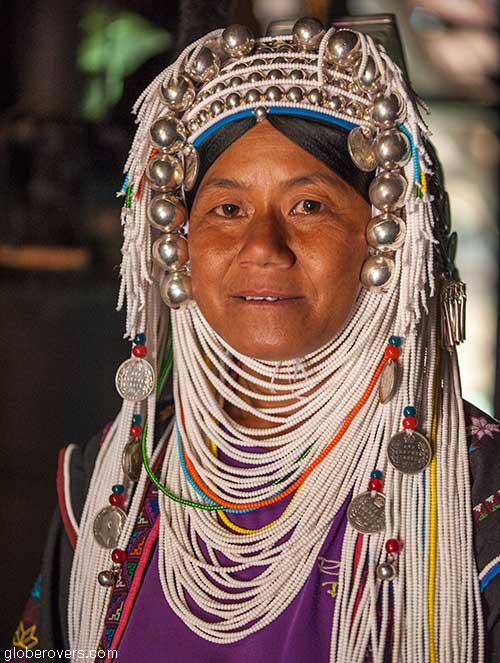
The design of the headdress differentiates the different Akha villages from one another. The most prominent difference in design is the shape of a small board at the back of the head – which could be square, round, or triangular, or could be a round loop which is worn, in limited numbers, by the Loimwe Akha group. Another variation, the “pointed helmet” headdress, is worn by the Aajao Akha people who live near Maing Kat, to the north of Kengtung.
Akha women are renowned for being kind and very hard working. They do their own spinning of cotton threads, weaving, and dying of cloth with indigo leaves for tailoring their traditional family clothes. Furthermore, the Akha women are very enthusiastic cooks. Before you leave Kengtung, make sure to drop by the Kengtung Central Market and pick up some fresh meat and vegetables for lunch, as well as a few gifts such as headache tablets, shampoo, and any other practical household items.
The Akha ladies are known as the “chefs of the hills” so bring meat and veggies from the morning market for a home-cooked lunch
At the village, your guide will find an eager recipient of the gifts and in return, she will make you a sumptuous wok stir-fry lunch with the meat and veggies you brought. The kitchen fire is made in the middle of the kitchen floor with no chimney. Smoke just seeps through the thatched roof of the house. While the food may be a bit oily, it comes with the best intentions. When lunch is finished, leave a tip discretely on the table. She truly deserves it.
Hiking WEST of Kengtung
The area to the west of Kengtung is home to the Lishaw, Wa, and the Lahu tribes. The name “Lahu” means “tiger hunters” and originates many centuries ago when this tribe was still living in China. The Chinese Emperor found them to be the best hunters and therefore bestowed upon them the name of Lahu, the “tiger hunters”. Their two subgroups, the Lahu-na and the Lahu-shi, respectively mean the “black tiger hunters” and the “yellow tiger hunters”.
As their forefathers and other humans decimated the tiger population, they can no longer hunt down the tigers, so now focus on hunting the remaining wild animals. They generally live in the hills at over 1,300 m above sea level and live off slash-and-burn farming in addition to their hunting.
West of Kengtung are some very interesting Lahu, Lahu-shi and Wa villages
The Lahu people are generally polytheistic, believing in more than one religion such as Christianity, Buddhism, and Animism. Most of the Lahu villages have no electricity or running water. Their diet consists mainly of rice, vegetables, and chillies. They are known to be very kind-hearted and hospitable to visitors, with men caring well for their wives and children.

A 45-minute drive from Kengtung in the west-northwest direction will take you to Kong Ma village. This friendly village of the Wa tribe is located in the valley so no hiking is required. While the people here no longer wear their traditional tribal clothes, it’s worth a visit to meet the very active and smiling kids and talkative adults. Unlike the wooden homes standing on stilts in the high hills, the houses here in the valley are constructed from adobe materials such as grass and bamboo encased in an orange clay.
The Lahu-shi tribe living in Pang Pak village is one of the most remote to reach within one day.
A 3-hour hike ends in a very warm welcome!
From Kong Ma it is a three-hour hike to one of the Lahu-shi villages, such as Pang Pak village. This village was established eleven years ago and has only 185 people living in 23 very basic houses. About 60% of the Lahu-shi inhabitants are Animists while the remaining people are Buddhists.
The girls here marry around the ages of 13 to 15 and will eventually give birth to no less than three or four babies, and perhaps up to 14. Once married, they will start wearing a little drum-shaped earring through each earlobe which will stretch to epic proportions as they grow older.

The Lahu-shi do not get married outside of their own tribe due to their Animist superstitions and their belief in maintaining their “true untainted bloodline”. If someone does marry outside the tribe, then the newlyweds must move far away from their village. The process of getting married is rather complicated: once a couple decides they want to marry, they inform their parents and ask for consent and blessings. Should the parents agree, they will get married, though no elaborate wedding reception is held. Rather, the immediate family will offer a get-together for the village and offer drinks. At this get-together, they ask for the blessing of the entire village.
Once achieved, the man moves in with his wife’s family and they start creating their own family. The groom then has a maximum of ten years to work and save money. Once he has enough money, he needs to buy the following gifts for his wife’s family: 22 Indian coins, 100-200 kg of rice, and 50-60 kg of pigs. If he does not have the money to buy these gifts within ten years, he and his family need to borrow the money. Once the gifts have been delivered and accepted, the village will come together for the official wedding reception. After the reception, the couple is free to live with either the bride’s or the groom’s parents, or they may move into their own house.

Like some other villages, the Lahu-shi women make clothes for the entire village from cloth which they buy in the nearby towns. They no longer weave their own cloth from locally produced cotton as they claim cotton has become hard to grow in their area. The colours of this specific village are beige (or maybe once was white) at the top, and a light blue skirt, pants, or longyi. As the village is quite high in the hills, it gets down to only about 7°C in winter, so their winter clothes need to provide enough protection.
The Lahu-shi people have a strict rule that forbids any alcohol in their village, even Shan-made rice wine. It is perfectly fine to smoke from an early age, including the girls. Locally grown tobacco is carefully rolled into corn leaves or even chestnut leaves. People here only smoke their home-made cigars, so no pipe smokers here. Smoking marijuana is forbidden.
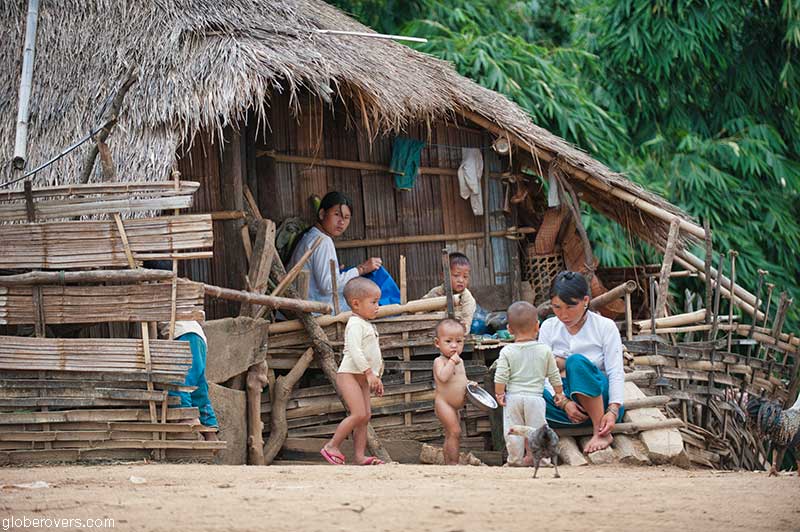
A couple of years ago, with help and funding from volunteers, a water tank was installed about one kilometre from the village. This provides clean water for the residents but water needs to be hauled into the village as there is no pipeline installed.
The limited electricity, which is locally generated by the small mountain streams, is just about enough to power up a few small light bulbs in each house. Televisions and other electronics are unheard of, except the odd home has a small radio which they use to tune in to Radio Lahu which transmits from China and Laos in the Lahu language. In addition to updating the villagers on world affairs, the radio station also keeps up the culture with traditional Lahu music. The audience is not small as the Lahu is the second biggest tribe in Shan State, after the Shan people.
While old Chinese phones are cheap, nobody has phones in the village.
Once you walk around in this remote village you will realise that money is very scarce. To generate an income, families cultivate their own domestic animals such as pigs, chickens and buffaloes, in addition to soybeans, peanuts, and corn. Their produce is then sold to other hill tribe villages or to the more affluent Shan villages in the valleys. The man is the head of the household and therefore in charge of the family finances.
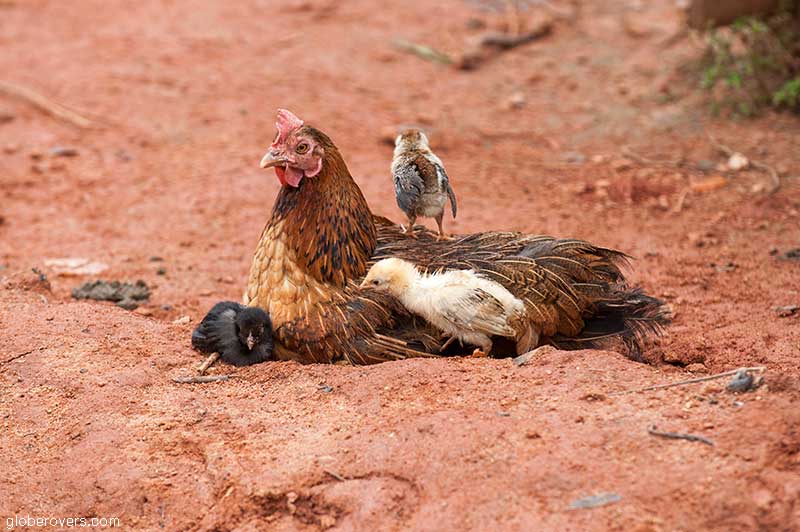
If you are lucky, your guide will let you settle down for a rest in one of the larger houses. Don’t be surprised when most of the village’s women and kids follow you into the house. They will sit around you in a large circle while the village chief prepares afternoon tea. Be ready to hand out some small gifts you bought at the Kengtung morning market. The people so much appreciate small handouts such as headache tablets, shampoo and healthy snacks.
Seeing the many kids enjoying the snacks is such a pleasure. Be sure to bring healthy low sugar snacks which are not individually packed (unlike the overpackaged cookies we brought as can be seen in the photo). To avoid littering the villages with plastic packaging, rather take out individually-packed snacks and place them in a larger bag before arriving at the village. Take any plastics or non-reusable containers back to the garbage dumps at Kengtung.
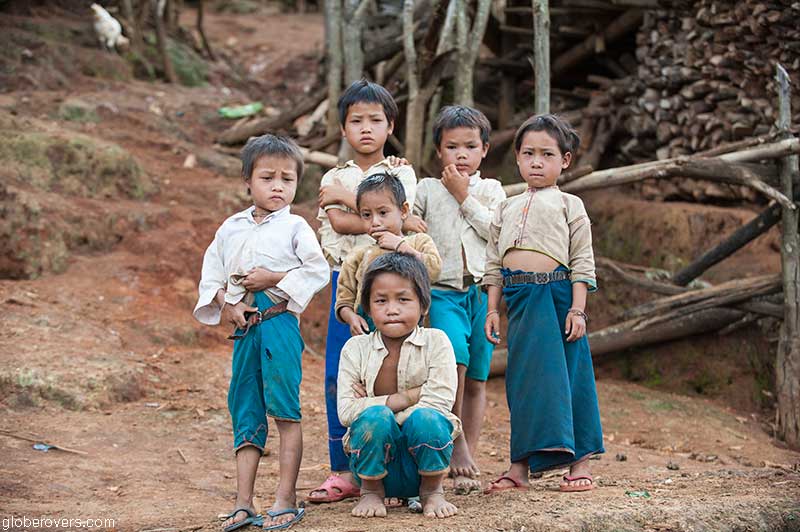
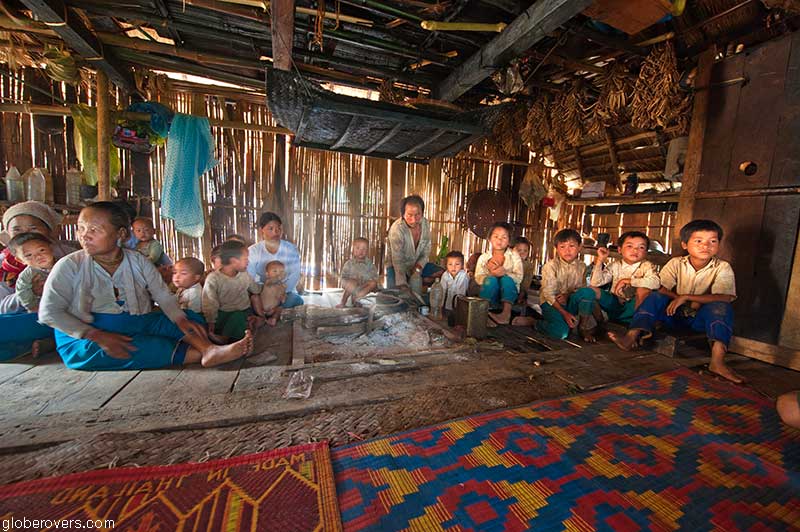
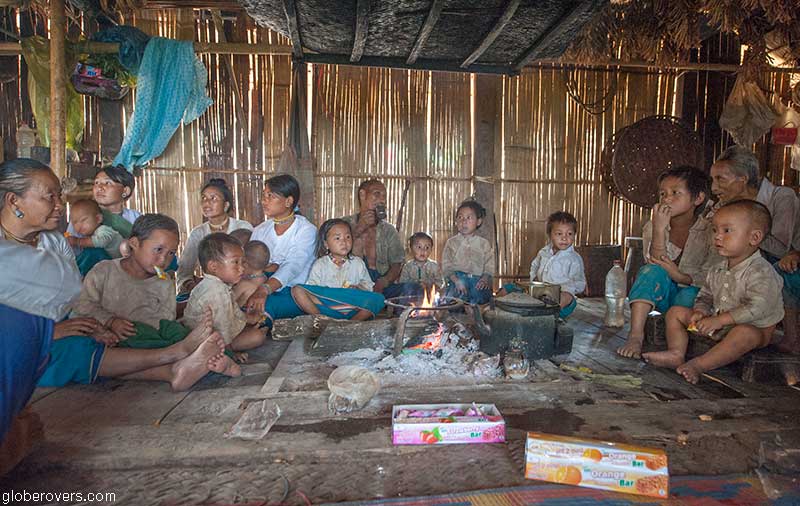
Before leaving this interesting and very friendly village, make sure to drop by the blacksmith hut to see how these men use their super-hot fire to tamper their big knives and machetes.
Hiking NORTH of Kengtung
About 90 minutes drive north of Kengtung you will find the Lahu-na tribal village of Pin Tauk and further on the Akha village of Wan Pin. The 800 villagers of Wan Pin are mainly Catholic and Baptists who live in about 160 houses. En route, stop over at the village of Wan Kong to see how they distil very potent alcohol from bags and bags of fermented rice. The workers will scoop out some freshly distilled liquor for you to taste. Take a deep breath. It is very potent!
North of Kengtung is the Lahu-na, Akha, and the “black-teeth” Ann tribe villages
About two to three hours’ hike uphill from the Akha village of Wan Pin past beautiful views of the valley, lies one of the most interesting hill tribe villages of the region. Pan Lea village is home to the Ann tribe, who prefer to call themselves the Va people, and are believed to be closely related to the Wa tribe. This small village has just 165 people living in 26 houses. They still wear their traditional tribal clothes which are mainly black with coloured buttons and a black headdress with a few white seashells arranged in a straight line at the front.
The Ann tribe living at Pan Lea village blacken their teeth which raises their status within the tribe
Like the Wa Ann women at Wan My village to the east of Kengtung, the Ann women of Pan Lea also blacken their teeth for similar reasons. Look out for the beautiful black smiles! They chew a variety of nuts such as betel nuts, mixed with crushed limestone and leaves which stain their mouths and teeth with a bright reddish colour. The chewing starts at an age of about 16 to 18 and overtime their teeth turn a shiny black. The older women in the village all have almost completely black teeth.
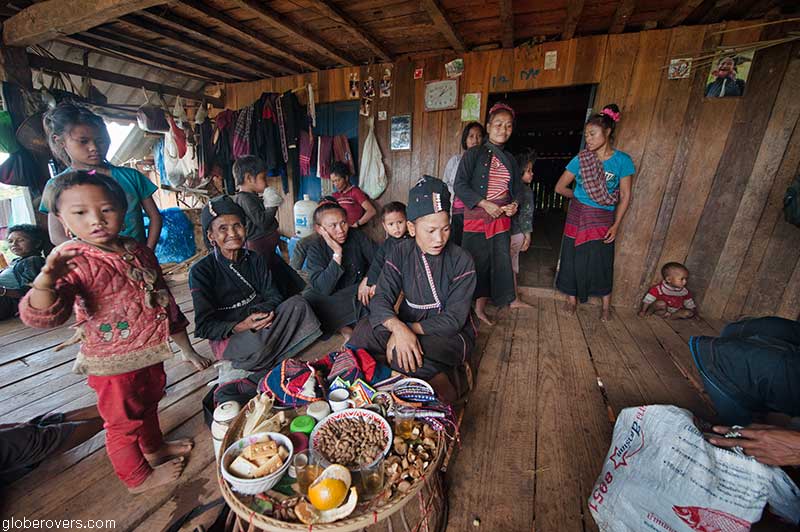
The people still wear their traditional clothes and weave and dye the cloth according to tradition.
The mortality among children is currently at about 30%, mainly from malnutrition. The main causes of death among the adult residents are high blood pressure, and water-borne diseases. High alcohol consumption is also a contributor to death. The average life expectancy is about 65 years.
All people in the village are Animist. Look out for the altar where sacrifices are made to the spirits. Some areas are only open to the shaman and those he invites inside. They fear water spirits and therefore build their villages along the mountain ridges, far away from rivers and marshes. Water for household use is piped into the villages through a series of hollow bamboo pipes.
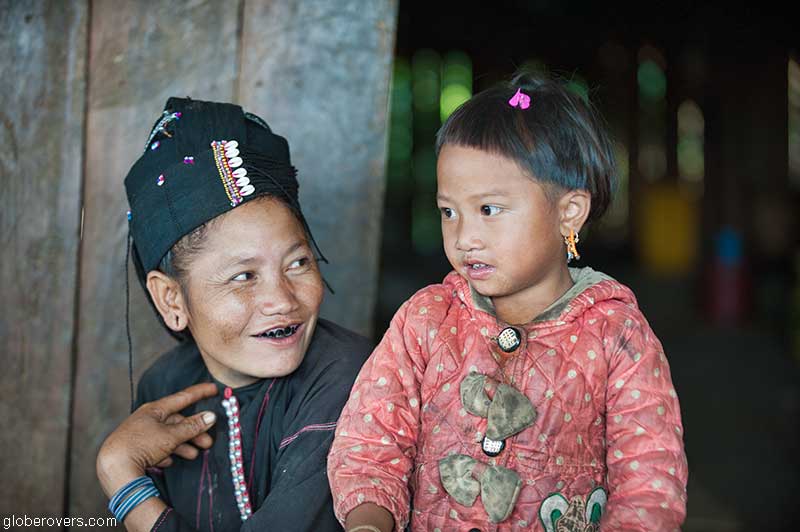
If you visit during a full moon in November you may witness the “Fertility Festival”, which originates from China, where the Ann people are originally from. Back then, the larger tribal groups often came to steal young girls from the smaller groups. To make up for the shortfall of females in the village, there was an urgent need to create more babies.
So, after the harvest time in November, animals would be killed and lots of food prepared for the village. Then, on this full moon night, the elders will go through the village to receive food offerings which are then taken to the house of the shaman where the entire village will congregate.
The shaman will scatter rice around the large floor on stilts and wine will be served around the shaman’s house where people are sitting grouped by age. The youngest people are not allowed to drink.
In the shaman’s house is a large drum which will be beaten while the drunken people dance to the drumbeat. At this time, he will choose an intoxicated elderly man and summons specific ancestral spirits to come into the man. The spirit (could be a water-, nature-, rice-, mountain-, or tree spirit) will then speak through the elder to make predictions for the village, or address questions about the harvest, rainfall, or any specific issues the village is having to deal with. All evil spirits are strongly avoided. The shaman will also walk around the village to drive out the evil spirits.
☛ Read more: Nagaland New Year Festival
One of the strongest men in the village will dance with a smaller man and pretend to have sex. This is to teach the young girls about the facts of life. After the show, several couples will get married and then start making babies. This Fertility Festival continues to be held in this village, every November.
After spending a few days hiking around the hills of Shan State and meeting with the friendly hill tribes, you will be so happy you ventured to this part of the world.
This tour was sponsored by ProNiti Travel in Yangon.
Contact them at sales@pronititravel.com to book your tour to Shan State.
☛ Read more: Myanmar’s Myeik (Mergui) Archipelago

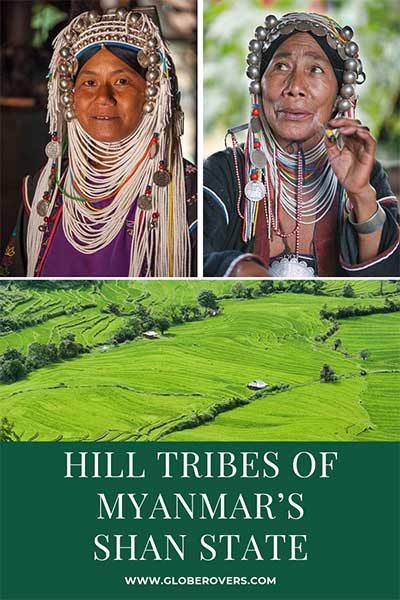
Further reading
- Ayeyarwady River Boat Journey: Myanmar
- Portraits of Nagaland – Myanmar
- The Hill Tribe People of Myanmar
- Cultural Encounters Myanmar
- Akha hill tribe – History and Culture
- Burma – Frontier Minorities In Arms

Blog post and photos by Peter who has been travelling almost full-time since 2005 and has been to over 122 countries. He visited several countries, such as Japan, more than 20 times. Peter is Editor-in-Chief and Publisher of GlobeRovers Magazine, an independent travel magazine focused on intrepid destinations.

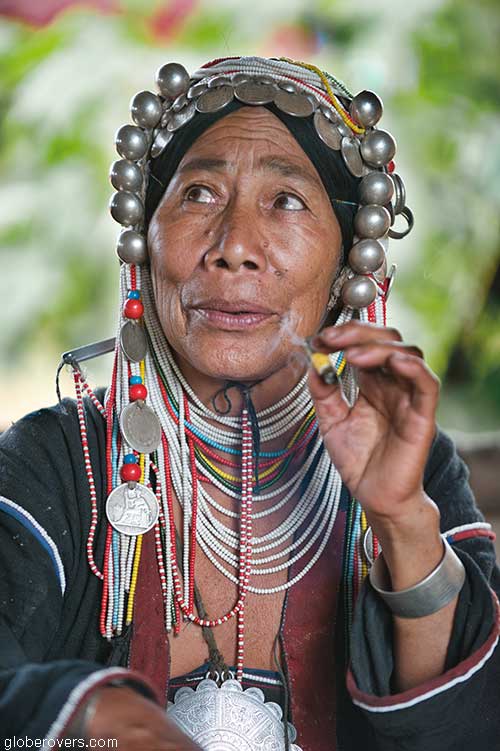

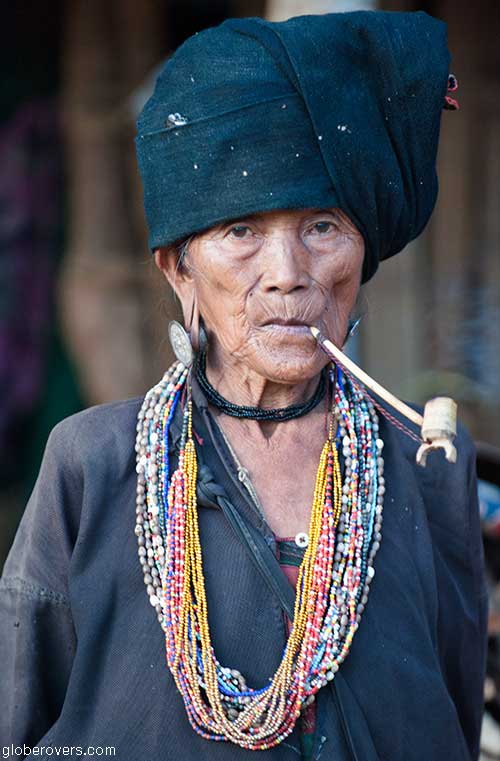
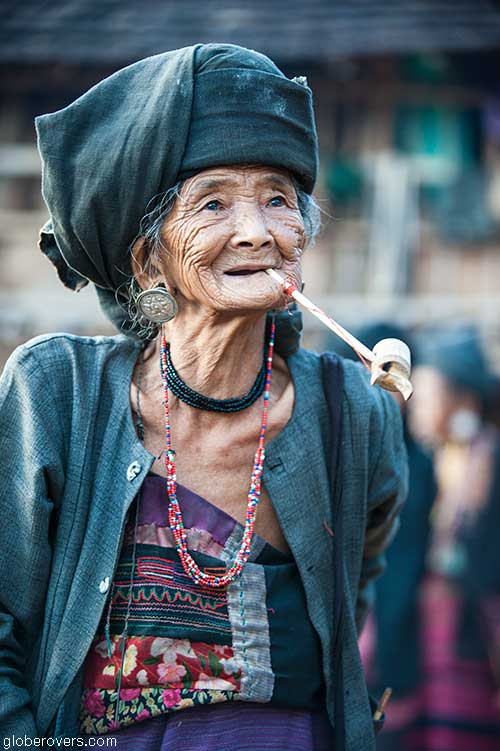



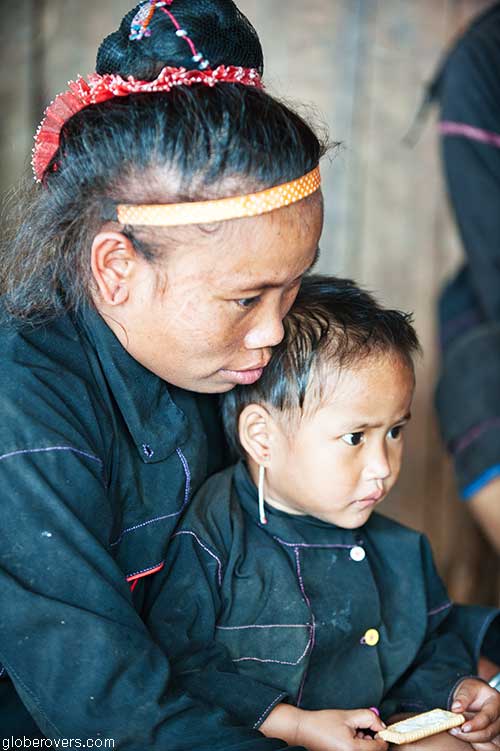
2 comments
[…] The Shan people, who dominate this state culturally and economically, arrived in this area along with the Mongols when the Pagan Kingdom (the first Burmese empire: 849 to 1287) fell to the Mongols in the 13th century. The Mongol invasion was launched after the last true ruler of Pagan, King Narathihapate (who reigned 1254 to 1287) refused to pay tribute to Kublai Khan, the “Great Khagan of the Mongol Empire”. The Mongols, under Kublai, delivered a crushing defeat at the “Battle of Ngasaunggyan” (1277), followed by the Battle of Bhamo (1283) and the Battle of Pagan (1287), which then brought an end to the Pagan Kingdom and the construction of the temples at their capital, Bagan. Shan State, located in the central far eastern part of the country, is the largest administrative region of Myanmar. Covering an area of almost 156,000 square kilometres, this state shares international borders with China to the north, Laos to the east, and Thailand to the south. With an estimated population of almost 6 million people, it is the fourth most populated region after the Yangon Region, the Ayeyarwady Region, and the Mandalay Region. […]
[…] Shan people, who dominate this state culturally and economically, arrived in this area along with the Mongols […]